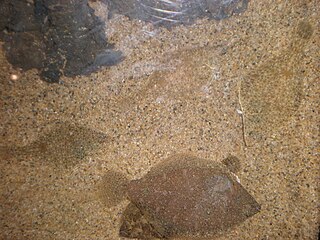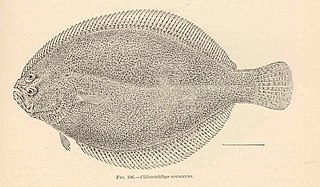
Citharichthys is a genus of flatfish in the large-tooth flounder family, Paralichthyidae. They have both eyes on the left sides of their heads. They are native to the oceans around the Americas, with a single species, C. stampflii off the West African coast. Most are found in relatively shallow depths, but the genus also includes species found in deep water and species that enter fresh water.

The California halibut or California flounder is a large-tooth flounder native to the waters of the Pacific Coast of North America from the Quillayute River in Washington to Magdalena Bay in Baja California. It feeds near shore and is free swimming. It typically weighs 6 to 30 pounds. It is much smaller than the larger and more northern-ranging Pacific halibut that can reach 300 pounds (140 kg).

Large-tooth flounders or sand flounders are a family, Paralichthyidae, of flounders. The family contains 14 genera with a total of about 110 species. They lie on the sea bed on their right side; both eyes are always on the left side of the head, while the Pleuronectidae usually have their eyes on the right side of the head.

The Pacific sanddab is a species of flatfish. It is by far the most common sanddab, and it shares its habitat with the longfin sanddab and the speckled sanddab. It is a medium-sized flatfish, with a light brown color mottled brown or black, occasionally with white or orange spots.

Citharichthys stigmaeus, the speckled sanddab, is a species of flounder in the genus Citharichthys. It is native to the eastern Pacific Ocean, ranging from Alaska in the north to Baja California, Mexico in the south.

Tephrinectes sinensis, the Chinese brill, is a species of flatfish in the large-tooth flounder family, Paralichthyidae. It is the only member of its genus Tephrinectes. Like the rest of the large-tooth flounders, it has both eyes on the left side of its head.
Thysanopsetta naresi is a species of flatfish in the large-tooth flounder family, Paralichthyidae. It is the only member of its genus Thysanopsetta. Thysanopsetta naresi is a demersal fish that lives in temperate waters at depths of between 90 and 170 metres. It can be found in the southeast Pacific Ocean, off the coast of Chile, and in the southwest Atlantic Ocean in Patagonia and in the Falkland region. It grows to around 15.1 centimetres (5.9 in) in length.
Pseudorhombus quinquocellatus, the five-eyed flounder, is a species of flatfish in the large-tooth flounder family, Paralichthyidae. It is a demersal fish that lives in tropical waters, inhabiting deep waters on the continental shelf of the western Pacific Ocean, from Taiwan in the north to Australia in the south.
Citharichthys gordae, the mimic sanddab, is a species of sanddab in the large-tooth flounder family Paralichthyidae. It is native to the eastern Pacific Ocean, found off the coast of Mexico. It has a limited distribution, found in the Magdalena Bay and along the Baja California peninsula, as well as part of the Gulf of California.
Citharichthys platophrys, the small sanddab, is a species of sanddab in the large-tooth flounder family Paralichthyidae. It is native to the eastern Pacific Ocean, ranging from the southern Gulf of California of Mexico in the north to Peru in the south.
Citharichthys fragilis, the Gulf sanddab, is a species of sanddab in the large-tooth flounder family Paralichthyidae. It is native to the eastern Pacific Ocean, ranging from the coast of Manhattan Beach, California in the north to the Gulf of California in the south.
Citharichthys gymnorhinus, the anglefin whiff, is a species of flatfish in the large-tooth flounder family Paralichthyidae. It is a demersal marine fish that inhabits the mid to outer continental shelf of the western Atlantic Ocean, in both tropical and subtropical waters. It ranges from the Bahamas and Florida in the north to Guyana and Nicaragua in the south, though larvae samples have also been collected off the coast of Canada. It occurs at depths between 35 and 200 metres, but is most commonly found in shallower waters.
Citharichthys gilberti, the bigmouth sanddab, is a species of flatfish in the large-tooth flounder family Paralichthyidae. It is native to the eastern Pacific Ocean, in tropical waters ranging from the Gulf of California in the north to Peru in the south. It occurs in shallow waters off the coast, to a maximum depth of 36 m (118 ft).
Citharichthys mariajorisae, the five-rayed sanddab, is a species of flatfish in the large-tooth flounder family Paralichthyidae. It is native to the eastern Pacific Ocean, in tropical waters ranging from the Gulf of California in the north to the Bay of Panama in the south. It is a demersal marine fish, inhabiting the sandy bottoms of shallow coastal waters at a depth between 10 and 45 metres.
Citharichthys amblybregmatus is a species of flatfish in the large-tooth flounder family Paralichthyidae. It is native to the western north Atlantic Ocean. It has been collected at a depth of 198 m (650 ft).

Citharichthys cornutus, the horned whiff, is a species of flatfish in the large-tooth flounder family Paralichthyidae. This bathydemersal marine fish inhabits the continental shelves of the western Atlantic Ocean, in both tropical and subtropical waters. It ranges from New Jersey in the north to Uruguay in the south, though larvae samples have also been collected off the coast of Canada. It occurs at depths between 30 and 400 metres, though it is usually found in deeper waters.

Citharichthys arenaceus, the sand whiff, is a species of flatfish in the large-tooth flounder family Paralichthyidae. This demersal marine fish inhabits the western Atlantic Ocean, occurring in shallow tropical coastal waters, as well as in estuaries, bays, and lagoons. It ranges from Florida, United States, in the north to the West Indies and Brazil in the south.

The bay whiff is part of the family Paralichthyidae. This family is known as "left-eye flounders". They are one of the most common flatfish of the Gulf of Mexico. They are benthic ambush predators with the ability to camouflage themselves on or just below the surface. They are often solitary animals with few individuals. They vary in color from light to dark in life and are brownish in color after death. They have two dark spots on the caudal peduncle and a light spot under the pectoral fin. The average size of the Bay whiff is 15 cm and the maximum recorded length is 20 cm. The lateral line is straight along the body. It has a large mouth. The opercle on the blind side has no cirri. Their pelvic fins are also asymmetrical.

The Gulf Stream flounder is a species of fish belonging to the family Paralichthyidae native to waters off eastern North America.
C. xanthostigma may refer to:






